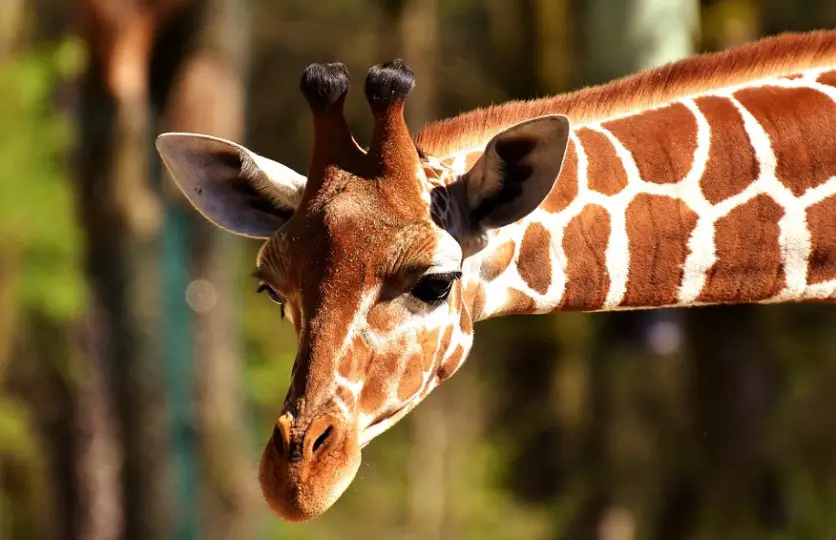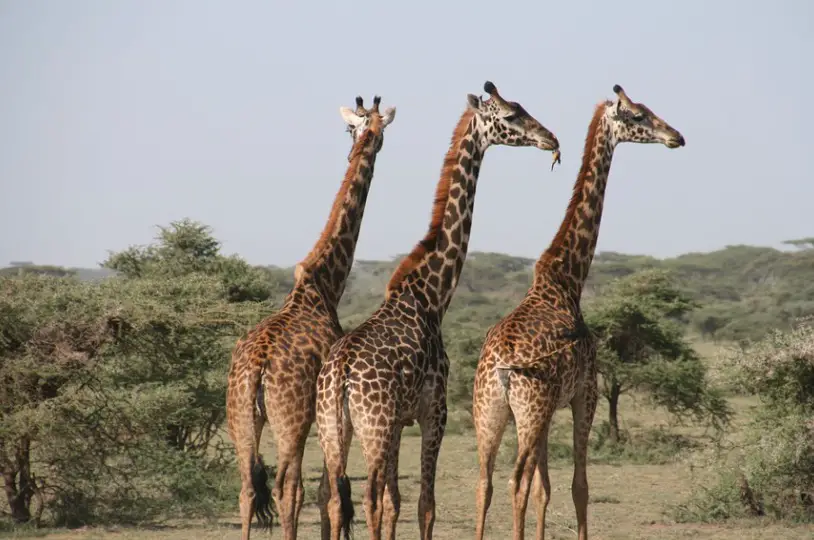Table of Contents
Giraffe: All You Need To Know
A giraffe is a herbivorous, browsing African mammal that belongs to the kingdom of Animalia, phylum Chordata, and class Mammalia. Its genus is Giraffa, and its species is Giraffa camelopardalis. Its length is 4.3 to 5.88 m, and it weighs about 794 to 1,930 kg. It lives in the Savannahs and open woodlands, with a lifespan of up to 10 to 20 years.

What is Giraffe?
The giraffe is a herbivorous animal that may be found in Africa’s savannahs and open woods. It has the longest neck of any living terrestrial mammal and is also the biggest ruminant. There are currently nine recognised subspecies of giraffe, but whether or not some of them should be regarded as distinct species is a point of contention.

Giraffes have a unique coat pattern with patches of orange, brown, or almost black fur divided by white or cream lines. Each giraffe has its own distinct coat pattern, but calves acquire some coat pattern features from their mothers.
Ossicones are two small, horn-like structures on the top of a giraffe’s head made of ossified cartilage connected to the skull and covered with skin. Ossicones are vascularized, which suggests that they have a function in thermoregulation, but they are also employed in male battles.

Giraffes favour the Acaciae subfamily and the genera Commiphora and Terminalia, which are high in calcium and protein and so assist their growth. Giraffes also eat bushes, grass, and fruit, eating around 75 lb (34 kg) of plant materials per day.
Despite being herbivores, giraffes have been observed licking dried meat off corpse bones. Giraffes are ruminants, which means they get nutrients from their food by fermentation rather than digestion, which needs their food to be regurgitated and chewed several times to break it down adequately.
Giraffes are noted for their long necks, which average approximately 6 feet (1.8 m) in length and are considered to have developed as a result of competition for food among African grazing herbivores. Longer-necked giraffes were thought to have evolved through time because they could reach food higher up in the trees, avoiding competition with other browsers like kudu and impala.
The giraffe’s neck, on the other hand, may have developed as a secondary sexual feature, with males with longer, heavier necks having an advantage over females in so-called ‘necking’ contests.
Giraffe Behavior and Reproduction
Giraffes cluster in herds of up to 60 individuals that fluctuate in size and composition depending on ecological, social, and temporal factors. Although mixed-sex groups of females and young males have been observed, herds are typically made up of only one sex.
Females are more choosy than males in who they connect with, and these affiliations are often based on shared space and perhaps family. Young guys create groups and participate in play battles, but as they get older, they become more lonely. Older males, on the other hand, may still socialise in pairs or with female groups.

Because giraffes are polygamous, elder men mate with several females while younger guys are left out. In order to demonstrate dominance, males may fight over females by participating in a behaviour known as ‘necking.’ Two guys massage their necks and lean on each other in low-intensity necking, with the individual who can stay more upright winning the battle.
High-intensity necking includes two guys swinging their necks at each other and attempting to strike their opponent with their ossicones. While most conflicts do not result in damage, they can result in broken jaws, broken necks, and even death.
Giraffes have a 400–460-day gestation period, following which females give birth to a single calf, but twins are occasionally seen. Giraffes are born with a height of 5.6–6.6 feet (1.7–2 metres) and can stand and run after only a few hours.
Newborns, on the other hand, spend their first few weeks of existence hiding from predators, relying on their coat pattern for concealment. Calves suckle for a variety of periods of time, ranging from a month to a year. Similarly, calves stay with their mothers for varying amounts of time, but can persist until a new calf is born.
Fun Facts About Giraffe!
The giraffe’s very long neck is only one of several adaptations that illustrate fascinating biological principles.
The Giraffe's Neck
Giraffes have a variety of physiological adaptations that enable them to thrive with such long necks. Given that these animals are ruminants, their digestive processes must be capable of regurgitating food all the way from the stomach to the mouth, a feat made possible by their oesophageal muscles’ remarkable strength.
Giraffes also have the world’s longest recurrent laryngeal nerve, which runs from the brain to the base of the neck before returning to the larynx. Individual nerve cells in the tallest giraffes are over 16 feet (5 metres) long.
Giraffes’ circulatory systems have also evolved to accommodate their long necks. A giraffe’s heart, for example, must create double the blood pressure necessary in humans to sustain blood flow to the brain. Their hearts have walls as thick as 3 inches (7.5 cm), are approximately 2 feet (6 m) long, and can weigh more than 25 pounds (11 kg).
When giraffes lower their heads, their circulatory systems must also prevent blood from returning to the head, which is accomplished in part by the jugular veins’ many one-way valves.
Cooperative Care of Young Giraffe
Several female giraffes and their calves frequently congregate in nursery herds that travel and feed together. These herds employ cooperative child care, in which a mother may leave her calf with the herd while foraging or drinking elsewhere.
Lions, spotted hyenas, and banded mongooses are among the animal species that practise this type of care. Caring for another individual’s babies appears to be a poor strategy for maximising reproductive success and fitness at first glance, thus it may be believed that this approach should be avoided.
Given that female giraffe herds are considered to be established in part based on family, it’s probable that while performing cooperative care, females are caring for their relatives. As a result, they continue to indirectly aid in the propagation of their genes, boosting their indirect fitness.
Giraffe Species vs Sub-species
It has long been assumed that there is just one species of giraffe, with nine subspecies differentiated by their various coat patterns. Recent genetic investigations, however, suggest that between two and six of these subspecies should be recognised as distinct species.
Despite the lack of physical obstacles to travel, scientists discovered that certain giraffe subspecies had not interbred for a long period of time by analysing the DNA of various populations. This reproductive isolation is considered to be caused by giraffes only mating with other giraffes that have the same coat type as them, and it is pushing diversification within the genus Giraffa.
The capacity to examine diverse populations at a genetic level has considerably enhanced our knowledge of evolutionary connections within and across species, which were formerly established solely by morphology. For example, DNA barcoding recently revealed that a single skipper butterfly species is actually made up of ten different species that seem virtually identical as adults.
Similarly, genetic methods have finally settled the question over whether African savanna and forest-dwelling elephants are separate species or not, revealing that they did indeed split into separate species between 2.6 and 5.6 million years ago.
Giraffe Citations
- The contribution of the giraffe to hemodynamic knowledge: a unified physical principle for the circulation. Cardiologia . 1999 Sep;44(9):783-9.
- Giraffe or leopard spot chorioretinopathy as an outstanding finding: case report and literature review. Int Ophthalmol . 2019 Jun;39(6):1405-1412.
- Giraffe Stature and Neck Elongation: Vigilance as an Evolutionary Mechanism. Biology (Basel) . 2016 Sep 12;5(3):35.







